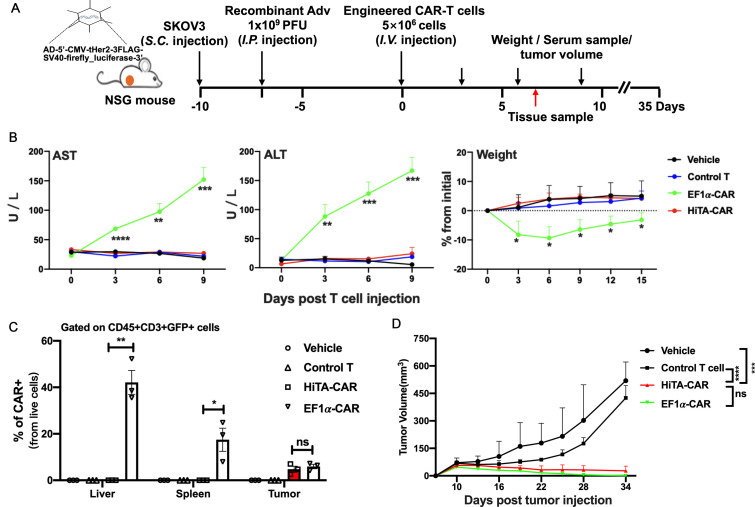Figure 8.
HiTA-CAR T-cells demonstrated anti-tumor efficacy without on-target off-tumor toxicity in vivo. (A) Overview of the experimental design for confirming the tumoricidal effect as well as reduced toxicity of HiTA-CAR- T cells in vivo. Mice were implanted with 1.5×106 HER2 +SKOV3 tumor cells. 1×109 PFU Ad5-Her2 was injected (i.p.) 7 days before 5×106 transduced (GPF+) T cells infusion (intravenous) (B) Liver damage was determined by serum ALT and AST levels collected at indicated time points. Weight change shown by percent change from initial weight (n=5, mean±SD is shown, a one-way ANOVA test was performed, and comparisons are shown between the HiTA-CAR and EF1α-CAR groups, *p<0.5, **p<0.01, ***p<0.001, ****p<0.0001). (C) The statistical results of proportion of CAR+ T cells in liver, spleen, and tumor tissues on day 7. (n=3, mean±SD is shown, *p<0.05, **p<0.01, ns: not significant analyzed using Student’s t-test). (D) The SKOV3 tumor growth curves are presented and the significant differences between HiTA-CAR group with other groups were analyzed (n=5, mean±SEM is shown, ***p<0.001, ****p<0.0001, ns: not significant, analyzed using two-way ANOVA). ALT, alanine aminotransferase; ANOVA, analysis of variance; AST, aspartate aminotransferase; CAR, chimeric antigen receptor; EF1α, eukaryotic elongation factor 1-α; HiTA, hypoxia-inducible transcription amplification; i.p., intraperitoneally; i.v., intravenous; s.c., subcutaneously.

